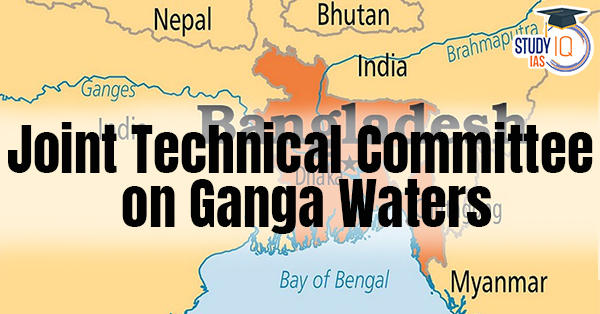Table of Contents
Ganga Water: Joint Technical Committee on
- Objective of the Ganga Water Committee: To conduct a study for optimum utilization of water received by Bangladesh under the provisions of the Ganga Water Sharing Treaty, 1996.
Ganga Water: Sharing Treaty, 1996
- India and Bangladesh share 54 common rivers of which, the Ganga Water and the Brahmaputra Water are the major ones and are integral in maintaining food and water security in Bangladesh.
- This treaty was signed in the year 1996, by the then Indian Prime Minister H. D. Deve Gowda and Bangladeshi Prime Minister Sheikh Hasina.
- Key provisions of the Ganga Water Treaty:
- The Ganga Water Treaty established a 30-year water-sharing arrangement (which is expected to be reviewed in 2026) and recognized Bangladesh’s rights as a lower-level riparian state.
- It allows for sharing of the Ganga Water during the lean season, January 1 to May 31.
- As per the 1996 treaty for the Ganga Water at Farakka , the division is as follows:
| Availability at Farakka | Share of India | Share of Bangladesh |
| 75,000 cusecs or more | 40,000 cusecs | Balance of the flow |
| 70,000 cusecs or less | 50% | 50% |
| 70,000 – 75,000 cusecs | Balance of the flow | 35,000 cusecs |
- Ganga Water treaty also permits the construction of barrages and irrigation projects by Bangladesh on Kushtia and the Gorai-Madhumati Rivers.
- Ganga Water treaty allows for the formation of a joint committee for implementing the arrangements contained in this treaty.

Ganga Water: Other Important Initiatives Announced during Bangladesh’s PM visit to India
- Water initiatives:
- Kushiyara River: Both nations inked an interim water sharing agreement for Kushiyara River, first such pact since the signing of the Ganga water treaty in 1996.
- Feni River: India requested for early signing of the interim water sharing agreement on Feni River, taking into account the urgent irrigation requirements of the State of Tripura.
- Teesta River: Bangladesh reiterated the long pending request for concluding the agreement on the sharing of the waters of the Teesta River, the draft of which was finalized in 2011.
- Bilateral connectivity:
- Both nations agreed to expedite efforts to improve bilateral and sub-regional connectivity through early operationalization of the BBIN Motor Vehicle Agreement.
-
- The BBIN Motor Vehicles Agreement was signed in 2015 at the BBIN (Bangladesh-Bhutan-India-Nepal) transport ministers meeting in Thimpu, Bhutan. It allows the four countries to ply their vehicles in each other’s country for transportation of cargo and passengers.
-
- They also agreed to implement the decision to start riverine services under the Protocol on Inland Water Transit and Trade (PIWTT).
- PIWTT was first signed in 1972 to improve trade between India and Bangladesh through inland water ways.
- Both nations agreed to expedite efforts to improve bilateral and sub-regional connectivity through early operationalization of the BBIN Motor Vehicle Agreement.
- Energy initiatives:
- The leaders agreed to implement projects to connect the power grids of both sides through the proposed high capacity 765 KV transmission line from Katihar in Bihar to Bornagar in Assam through Parbatipur in Bangladesh.
- The two delegations also reviewed the progress of the India-Bangladesh Friendship Pipeline Project (IBFPP) which will further boost energy supply in Bangladesh.
- IBFPP was signed in 2018. It is a 130km oil pipeline that will connect Siliguri in West Bengal in India and Parbatipur in Dinajpur district of Bangladesh.
- Other initiatives:
-
- Mujib Scholarship: PM of Bangladesh announced the Mujib Scholarship for the direct descendants of the Indian soldiers killed or injured in the 1971 Bangladesh Liberation War.
- Conservation of the Sundarbans: The Leaders stressed on the effective implementation of the 2011 MoU on ‘Conservation of the Sundarbans’ so that the ecosystem of this deltaic forest and the people dependent on this ecosystem can live sustainably.
-





















 WhatsApp
WhatsApp